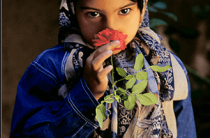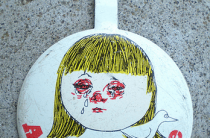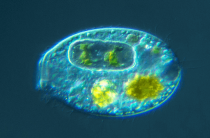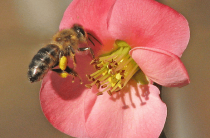Allergy to flowering plants is one of the most common forms of allergy. At the same time, its source is also widespread. Plants are found everywhere, without them it is simply impossible to live. And it’s not worth it, because such drastic measures are not needed when you know the nature of the allergy, methods of prevention and follow the correct treatment prescribed by a specialist.
Basically, pollen allergy is the lot of city dwellers. At first glance, this seems absurd, because plants are much less common in the city, and therefore their pollen. But this only contributes to its spread. In rural areas, the abundance of grasses, shrubs and trees hinders the spread of pollen. In the city, however, it spreads without the slightest difficulty. In addition, urban air pollution by industrial products, as well as exhaust gases. On the one hand, these factors provoke the occurrence of allergic diseases, on the other hand, they exacerbate their symptoms, provoking additional irritation of the nasopharynx.
Allergy to plant pollen, as such, is very rare. Basically, there is an allergy to the pollen of one, less often - several. Allergies can be to grasses, shrubs or trees.
The main difficulty for those who encounter an allergy for the first time is its almost complete identity to colds, at the initial stage of the disease. In the first days of flowering of the allergen plant, the patient experiences a general deterioration in well-being, which is accompanied by fever, a runny nose, sometimes a dry cough is added to this, which only enhances the similarity of these diseases.
Plants that are allergic to pollen
Any plant can be the culprit for a pollen allergy. An allergy can be not only to pollen, but also to fruits, etc., but pollen allergy is characterized by its own characteristics of the course, so it is customary to single it out separately. The wind that spreads pollen carries it over considerable distances, but nevertheless, the most dangerous places for an allergic person are parks, squares, meadows, plantings and flower beds.
The pollen of coniferous plants (pine, juniper, cypress, etc.) is often a provocateur of allergic diseases. Especially, in this regard, residents of large industrial cities were not lucky, where these plants are planted in large numbers to purify the air.
Among the trees, most often allergic are plants such as oak, birch, alder, linden. Pollen from fruit plants: apple, cherry, peach, apricot, sweet cherry, etc. It can also cause allergic reactions in people who are sensitive to its components. People who are allergic to the flowering of cereals and various grasses are most vulnerable, because these plants bloom longer than others, and some even twice a season.
And of course, speaking of allergy provocateur plants, ragweed cannot be ignored. This low shrub, which releases large amounts of highly allergenic pollen into the air, is completely alien to our habitats, and therefore causes allergies quite often. His homeland is distant America, whose inhabitants are more accustomed to this shrub, and, accordingly, to its pollen. Ambrosia is also a great danger because it releases just a huge amount into the air and at the same time is very unpretentious and grows almost everywhere.
People living in private homes need to take care of the extermination of this shrub in the spring. It is advisable to do this in the middle of spring, when it is just beginning to erupt.
Flower allergy symptoms
And so, an allergy to flowering is an allergy of the so-called respiratory group. Symptoms, with this allergy, mainly affect the organs of vision and the respiratory tract. With the onset of flowering, a general deterioration in well-being appears, the patient's temperature rises, fever and aching muscles and joints are felt, a runny nose and dry cough appear.
Respiratory manifestations are marked by inflammation of the eyes, their redness, increased lacrimation, nasal congestion, persistent runny nose, irritation of the mucous membranes and their increased sensitivity to other irritants.
Sometimes, the accompanying symptoms are increased irritability of the patient, or vice versa, constant weakness, fatigue, drowsiness. In any case, allergy symptoms cause a lot of trouble for the patient and it is desirable to eliminate them as quickly, efficiently and safely as possible.
Nose drops for allergies to flowering
With an allergy to flowering, the use of a nasal drop is an effective and relatively safe remedy for relieving symptoms that are localized in the nasopharynx. To date, the pharmaceutical industry has a large number of drugs to relieve allergy symptoms, produced in the form of drops. First of all, in the treatment of an allergy to flowering, drops containing antihistamines are used. In some cases, they do not have the desired therapeutic effect. In this case, hormonal corticosteroid drops are used. Also used are vasoconstrictor and special sprays for rinsing the nose.
Antihistamine nasal drops
Antihistamines are a group of drugs that block histamine. Histamine is the main culprit in the occurrence of allergies, since cells sensitive to it are located in the skin and mucous membranes, forming the basis of these tissues. In general, in most cases, this is a very effective group of drugs. The disadvantage of them is that a number of other hormonal and neuro-regulatory factors also cause allergy symptoms. Alas, these substances, antihistamine drops have no effect.
Allergodil is a nasal spray containing azelastine hydrochloride. They are a highly effective form of antihistamines for local use. Allergodil effectively relieves seasonal manifestations of pollen allergy, relieves swelling of the nose, reduces the discharge of fluid from the sinuses, and stops sneezing. Allergodil is used in 1 injection, twice a day. Adults and adolescents may use more frequently if there are special instructions.
Opatanol - olopatadine hydrochloride, in the form of drops for injection into the nose. It has the most pronounced histamine-blocking effect. It also has the ability to prevent the transport of eosinophils to inflamed areas, which reduces the manifestation of symptoms, since the concentration of antibodies decreases in places of allergic manifestations.
When using opatanol, the following side effects may occur: a feeling of nausea, general weakness, lethargy, migraines, a violation of smell and taste sensations. In general, opatanol is very effective when applied as a nosebleed for allergies to flowering, especially as a preventative measure 3-5 days before flowering.
Fenistil are effective nasal drops that are used to relieve symptoms of pollen allergy. It has a pronounced inhibitory effect on the central nervous system, which manifests itself in daytime sleepiness, lethargy, a constant feeling of fatigue and lethargy. They try not to use the drug, from the 3rd to the 9th month of pregnancy. Also, fenistil is not suitable for the treatment of asthmatic manifestations. A significant advantage of fenistil is its combination with corticosteroid agents for topical use. These drugs also affect the symptoms of allergies and, in case of severe development, are used together to increase efficiency.
Benefits of antihistamine nasal drops:
- High, in most cases, efficiency;
- Often, it is enough to use once a day;
- Relatively safe and convenient remedy for allergy symptoms
- Suitable for long term use
Flaws:
- Does not eliminate allergy symptoms in all cases;
- Do not affect other mechanisms of manifestation of an allergic reaction;
- May cause common side effects;
- Inhibit the immune system of the nasal mucosa;
Mast Cell Stabilizer Drops
And so, this is another type of drug that is effective for allergies. Its mechanism of action is based on preventing the opening of the mast cell membrane. Mast cells contain histamine and other factors leading to an inflammatory process, an allergic reaction. During an allergy, antibodies come into contact with receptors on the surface of mast cells. This leads to the release of histamine, which causes symptoms. Substances - stabilizers (ludoxamide, cromoglycelic acid) are able to prevent the release of histamine from mast cells.
Corticosteroid nasal drops
Corticosteroids are substances that are analogues of cortisol and are able to eliminate the manifestation of allergic reactions. Corticosteroid drugs act effectively at all parts of the allergic chain, interrupting the body's reaction to the allergen. They try not to use these drugs for long-term therapy, since they can cause significant side effects with frequent and prolonged use.
The use of corticosteroids can eliminate allergic reactions, relieve inflammation and vasodilation caused by allergies. It must be remembered that the action of corticosteroid drugs is aimed at suppressing the immune system, so special care must be taken in relation to respiratory viral diseases.
Beclovent (beclomethasone) is an effective remedy for relieving the symptoms of allergic rhinitis. Beclovent dosages are prescribed individually by the attending physician, since this drug has a wide range of applications. They can range from 200 mcg per day to 2000. This drug is not used in the first trimester of pregnancy, as well as while breastfeeding.
Despite the high risk of side effects, corticosteroids are effective in relieving the symptoms of allergic rhinitis. Their rapid action on all manifestations of an allergic reaction, as well as a high therapeutic effect, make them highly demanded for the treatment of allergic diseases.
Vasoconstrictor and other drugs
Allergies when exposed to pollen are often accompanied by a sharp expansion of blood vessels, which causes severe congestion and swelling. In order to eliminate this adverse symptom, special drops are used that contain substances that affect alpha adrenaline receptors and thereby increase the tone of blood vessels in the nasal cavity.
In no case should you take vasoconstrictor drugs on an ongoing basis. They are used only for short-term relief of acute manifestations of allergic rhinitis. Thereafter, therapy is continued by safer means. Vasoconstrictor drugs cause strong drug dependence.
Naphthyzine is a well-known vasoconstrictor that has an almost instantaneous effect. Apply a few drops into each sinus 2 to 4 times a day. The use of naphthyzinum for more than 4 days in a row is fraught with the development of drug dependence.
Also, with an allergy to pollen, washing the sinuses with saline solutions or sea water is effective. This procedure allows you to eliminate the pollen that is contained in the nasal cavity. The main thing to remember is the correct calculation in the combination of dosages of various drops, which can be applied with a difference of several hours. This must be taken into account when applying various drops.
Remember that this article is a reference material and is intended purely for information. Allergies should only be treated by specialists.















